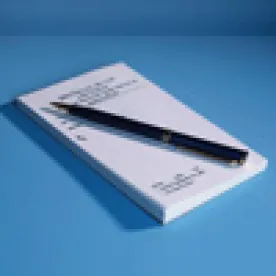In an en banc decision issued in The Medicines Company v. Hospira, Inc., the Federal Circuit determined that in order for a commercial transaction to trigger the on-sale bar of § 35 USC 102(b), it must “bear the general hallmarks of a sale pursuant to Section 2-106 of the Uniform Commercial Code.” Unlike the three-judge panel who first decided the case in July 2015, the full court determined that the contract manufacturing transaction for commercial quantities of Angiomax® did not rise to that level, and so affirmed the district court’s holding that it did not trigger the on-sale bar.
The Commercial Transaction At Issue
The patents at issue were U.S. Patent 7,598,343 and U.S. Patent 7,582,727, which are listed in the Orange Book for The Medicines Company’s Angiomax® (bivalirudin) product. The ‘343 patent claims a product made by a process that uses a pH-adjusting agent, while the ‘727 patent claims a pH-adjusted product. Both patents have a priority date of July 27, 2008, so the “critical date” for purposes of the on-sale bar is July 27, 2007.
According to the Federal Circuit decision, “MedCo is a specialty pharmaceutical company that does not have its own manufacturing facilities and is not capable of making its products in-house.” Thus, as stated in the decision, “In late 2006, MedCo paid Ben Venue $347,500 to manufacture three batches of bivalirudin according to the patents-in-suit.”
The On Sale Bar
The on-sale bar is embodied in the pre-AIA version of 35 USC § 102(b), which provides:
A person shall be entitled to a patent unless…
(b) the invention was patented or described in a printed publication in this or a foreign country or in public use or on sale in this country, more than one year prior to the date of the application for patent in the United States.
The 1998 Supreme Court decision in Pfaff v. Wells Electronics, Inc., sets forth a two part test for determining whether there has been an on-sale bar:
The on-sale bar … applies when, before the critical date, the claimed invention (1) was the subject of a commercial offer for sale; and (2) was ready for patenting.
At issue here was whether the first prong of the test was satisfied–whether the claimed invention had been the subject of a commercial sale. The court noted that for the purposes of § 102(b), “the question of whether an invention is the subject of a commercial offer for sale is a matter of Federal Circuit law, to be analyzed under the law of contracts as generally understood.” The court summarized its on-sale bar decisions as follows:
We … have held that, to be true to Pfaff when assessing prong one of § 102(b), we must focus on those activities that would be understood to be commercial sales and offers for sale “in the commercial community.” …. We have also indicated that, “[a]s a general proposition, we will look to the Uniform Commercial Code (‘UCC’) to define whether . . . a communication or series of communications rises to the level of a commercial offer for sale.” …. And we have made clear that, post-Pfaff, “[t]he transaction at issue must be a ‘sale’ in a commercial law sense,” and that “[a] sale is a contract between parties to give and to pass rights of property for consideration which the buyer pays or promises to pay the seller for the thing bought or sold.”
Applying UCC principles to the facts at hand, the court determined that “the transactions between MedCo and Ben Venue in 2006 and 2007 did not constitute commercial sales of the patented product.” The court identified “three reasons for [the] judgment in this case:”
-
only manufacturing services were sold to the inventor—the invention was not
-
the inventor maintained control of the invention, as shown by the retention of title to the embodiments and the absence of any authorization to Ben Venue to sell the product to others
-
“stockpiling,” standing alone, does not trigger the on-sale bar
Overall, the court reasoned:
commercial benefit—even to both parties in a transaction—is not enough to trigger the on-sale bar of § 102(b); the transaction must be one in which the product is “on sale” in the sense that it is “commercially marketed.”
Balancing Business Realities Against Patent Incentives
The court explained that its interpretation served the primary goal of the on-sale bar:
Rather than rest our decision on formalities, our focus is on what makes our on-sale bar jurisprudence coherent: preventing inventors from filing for patents a year or more after the invention has been commercially marketed, whether marketed by the inventor himself or a third party.
The en banc court noted that Hospira’s position (and the panel decision) would “penaliz[e] a company for relying, by choice or by necessity, on the confidential services of a contract manufacturer.”
There is no room in the statute and no principled reason raised by the parties or any of the amici to apply a different set of on-sale bar rules to inventors depending on whether their business model is to outsource manufacturing or to manufacture in-house.”
Citing the amici briefs of the Biotechnology Innovation Organization, American Intellectual Property Law Association, Gilead Sciences, Inc., and Pharmaceutical Research and Manufacturers of America, the court noted that “the amici uniformly argue that applying the on-sale bar to the type of transaction that occurred here would only make the drug development process more costly, punish efficient use of resources, and deter future investments in innovation.”
The en banc court therefore affirmed the district court’s holding that the transactions between Ben Venue and MedCo did not trigger the on-sale bar, and remanded the decision to the original panel to address the issues it did not reach before–such as whether a Distribution Agreement between MedCo and ICS triggered the on-sale bar.




 />i
/>i

